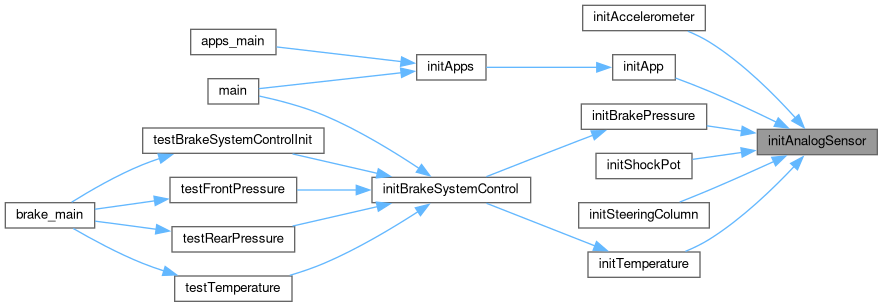#include "../../Inc/Sensors/AnalogSensor.h"#include "../../Inc/Utils/Constants.h"#include <stdio.h>#include <string.h>#include "stm32f7xx_hal.h"
Go to the source code of this file.
Functions | |
| void | initAnalogSensor (AnalogSensor *analogSensor, const char *name, int hz, int channel, void *child) |
| Initializes an analog sensor and configures the corresponding GPIO pin. More... | |
| void | ProcessADCData (uint32_t *adc1_buffer, uint32_t *adc2_buffer, uint32_t *adc3_buffer) |
| Processes ADC data from all three ADCs and stores it in the circular buffer. More... | |
| float | getAnalogSensorData (AnalogSensor *sensor) |
| Retrieves analog sensor data for a specific channel. More... | |
Variables | |
| static uint16_t | adc_samples [ADC_CHANNELS] |
Function Documentation
◆ getAnalogSensorData()
| float getAnalogSensorData | ( | AnalogSensor * | sensor | ) |
Retrieves analog sensor data for a specific channel.
- Parameters
-
sensor Pointer to the AnalogSensor structure
- Returns
- int The current ADC value for the specified channel
This function returns the latest ADC value for the channel specified in the AnalogSensor structure. If an invalid channel is specified, it returns 0.
Definition at line 89 of file AnalogSensor.c.

◆ initAnalogSensor()
| void initAnalogSensor | ( | AnalogSensor * | analogSensor, |
| const char * | name, | ||
| int | hz, | ||
| int | channel, | ||
| void * | child | ||
| ) |
Initializes an analog sensor and configures the corresponding GPIO pin.
- Parameters
-
sensor Pointer to the AnalogSensor structure to initialize name Name of the sensor (string) hz Sampling frequency in Hertz channel ADC channel number for the sensor (0-16)
This function initializes the base sensor properties, sets the ADC channel, and configures the corresponding GPIO pin based on the channel number.
Definition at line 42 of file AnalogSensor.c.


◆ ProcessADCData()
| void ProcessADCData | ( | uint32_t * | adc1_buffer, |
| uint32_t * | adc2_buffer, | ||
| uint32_t * | adc3_buffer | ||
| ) |
Processes ADC data from all three ADCs and stores it in the circular buffer.
- Parameters
-
adc1_data Pointer to ADC1 data buffer (channels 0-5) adc2_data Pointer to ADC2 data buffer (channels 6-11) adc3_data Pointer to ADC3 data buffer (channels 12-15)
This function combines data from all three ADCs into a single ADCSample and adds it to the circular buffer. It also sends debug information via UART.
Definition at line 58 of file AnalogSensor.c.

Variable Documentation
◆ adc_samples
|
static |
Definition at line 13 of file AnalogSensor.c.